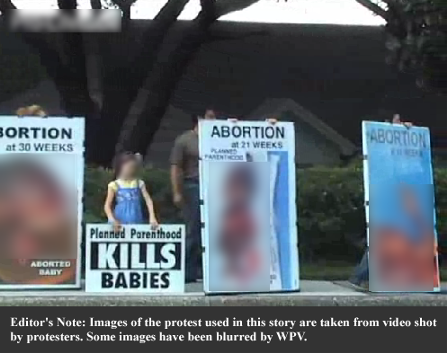 One day in mid-August, Jenna Tosh, President of Planned Parenthood/Orlando, found a disturbing flyer sitting unstamped in her mailbox. Hers was one of many, left by protest supporters who had moved through the neighborhood quietly distributing the flyers. One day in mid-August, Jenna Tosh, President of Planned Parenthood/Orlando, found a disturbing flyer sitting unstamped in her mailbox. Hers was one of many, left by protest supporters who had moved through the neighborhood quietly distributing the flyers.
The message was clear. They wanted Jenna and her neighbors to know — We’re Coming.
On Saturday, August 18, protesters kept their promise. They appeared on the sidewalk in front of the Tosh residence — armed with huge images of aborted fetuses and an accusation of baby killing on a placard held by a young girl.
UPDATE: Residential anti-protest ordinance passes on a 4 to 1 City Commission vote. Mayor Bradley cast the sole opposing vote. Opinion was evenly split among the 20+ men and women who spoke out on the ordinance during the hearing comment period.
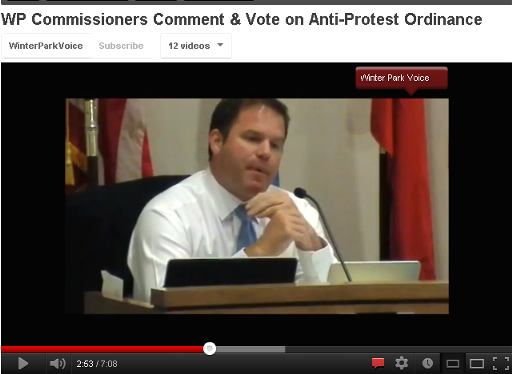
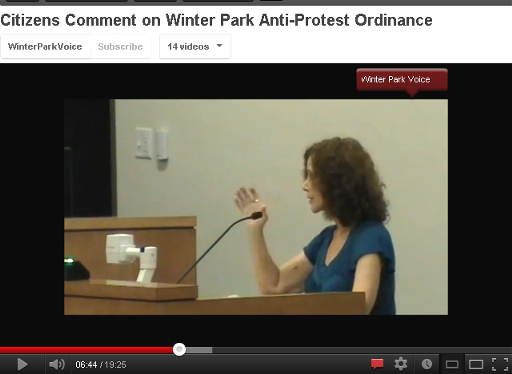
The confrontation began when Jenna and her husband returned home from a walk, pushing their three year old son in a stroller. According to Tosh, as the family struggled to get safely inside their home, they were forced to push past thirty protesters and their grisly placards.
The protest ended a short time after the confrontation, but not before a protest videographer filmed the confrontation, preserving the event for future use. The video and a written narrative of the event were quickly posted on the web by pro-life organizer Jay Rogers.
These are excerpts of the protesters’ own account of the Aloma Avenue protest:
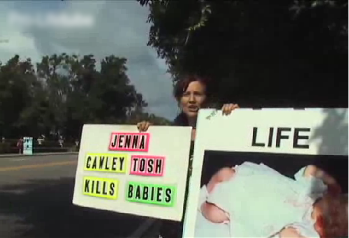 “Andrew and Jenna Tosh went for a walk in their upper middle class neighborhood with their young son in a stroller and dog on a leash. Upon returning to their home they were greeted by the sight of 28 pro-life evangelists lining the sidewalk in their neighborhood on Aloma Avenue. Many were holding graphic signs depicting aborted babies from six weeks gestation through late term. “Andrew and Jenna Tosh went for a walk in their upper middle class neighborhood with their young son in a stroller and dog on a leash. Upon returning to their home they were greeted by the sight of 28 pro-life evangelists lining the sidewalk in their neighborhood on Aloma Avenue. Many were holding graphic signs depicting aborted babies from six weeks gestation through late term.
Someone promptly called the police. The Tosh family was then able to run the gauntlet of pro-lifers. Most did not recognize Jenna as the new CEO of Planned Parenthood of Greater Orlando and simply greeted them as passersby. Arriving at her front door, she summoned a police officer that had arrived in her driveway and briefly burst into tears.”
Tosh Calls Commissioner Sprinkel: Please Help
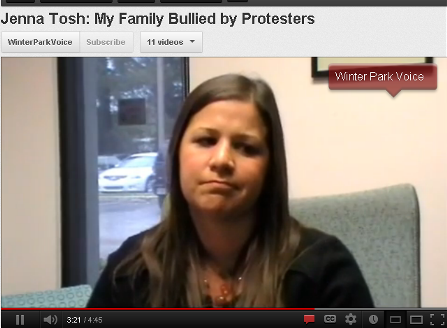 In the aftermath of the protest, Ms. Tosh reached out to her church for help and contacted a fellow church member, Winter Park Commissioner Sarah Sprinkel. Ms. Sprinkel moved quickly to request city action — an emergency ordinance designed to restrict protests in city neighborhoods. The temporary ordinance was passed unanimously by the City Commission on August 27. In the aftermath of the protest, Ms. Tosh reached out to her church for help and contacted a fellow church member, Winter Park Commissioner Sarah Sprinkel. Ms. Sprinkel moved quickly to request city action — an emergency ordinance designed to restrict protests in city neighborhoods. The temporary ordinance was passed unanimously by the City Commission on August 27.
WPV video of the hearing includes excerpts of Commission deliberations and the testimony of Jenna Tosh.
VIDEO: Emergency Ordinance Hearing
WP Protest Organizer Has History Targeting Central Florida Clinics
 Jay Rogers, an organizer of the Aloma Avenue protest, notes on his website that “None of the pro-life community, who are the thinly veiled targets of the ordinance, were at first made aware of emergency measure. However, several were able to appear at the first announced public hearing.” Mr. Rogers, who did appear and speak at the next Commission meeting, is a veteran of the Central Florida pro-life protest community. Jay Rogers, an organizer of the Aloma Avenue protest, notes on his website that “None of the pro-life community, who are the thinly veiled targets of the ordinance, were at first made aware of emergency measure. However, several were able to appear at the first announced public hearing.” Mr. Rogers, who did appear and speak at the next Commission meeting, is a veteran of the Central Florida pro-life protest community.
On his website, which promotes his beliefs, his mission and the sale of numerous video products, Rogers writes openly of his involvement in numerous pro-life “Awareness Campaigns”. In years past, Mr. Rogers’ commitment to his cause extended to the purchase of a home directly across the street from a Melbourne women’s health center.
Organizer Buys House Across from Clinic — Protests from Front Lawn
Rogers writes, “In 1993, I moved to Melbourne, Florida, a nice beach community just south of Cape Canaveral in Brevard County. There I bought a house across the street from one of America’s most notorious abortion clinics.” After buying the house, Rogers created a business name that enabled him to erect a mailbox for the home in the name of “The Killing Place”.
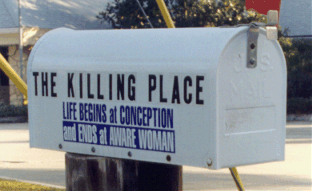 An article posted on Roger’s website explains his strategy. “Jay owns the house across the street from Aware Woman but his mailbox is on Aware Woman’s side of the street because the post office only delivers mail on that side of the street on Dixie Way. . . Jay’s mailbox is in the infamous “36-foot buffer zone.” Graham Dugas, who was also a resident at the house at the time, was arrested and jailed on a buffer zone injunction violation charge while going to mail a letter in his own mailbox. . . An article posted on Roger’s website explains his strategy. “Jay owns the house across the street from Aware Woman but his mailbox is on Aware Woman’s side of the street because the post office only delivers mail on that side of the street on Dixie Way. . . Jay’s mailbox is in the infamous “36-foot buffer zone.” Graham Dugas, who was also a resident at the house at the time, was arrested and jailed on a buffer zone injunction violation charge while going to mail a letter in his own mailbox. . .
According to Rogers, the buffer zone in the proposed Winter Park ordinance reminds him of past run-ins with authorities. “As one who dealt for a number of years with a no-free-speech buffer zone in my front yard that made it all the way to the Supreme Court, it’s deja vu all over again.” Rogers states that he was unsuccessfully sued by the Aware Woman’s clinic (AWCC) and provides on his website details of a lawsuit including these claims by AWCC:
“JOHN C ‘JAY’ ROGERS . . . owns, has primarily resided in, and has encouraged and permitted the use of the “Spy House” at 1575 Dixie Way, Melbourne, from the outset, for negligent, reckless, and tortious activities . . . Huge phony poster signs that are in violation of city codes, and contain defamatory, false & misleading allegations, are a routine form of continuous harassment from the lawn of the “Spy House.” . . . this form of harassment is ubiquitous and a daily phenomenon. Defendants often carry the bloody giant fetus signs into the buffer zone and AWCC driveway to harass and intimidate AWCC clients.”
Organizer Website “How-To” Guide Suggests Monthly Neighborhood Picketing
While Rogers’ “buffer zone” story offers a glimpse into the tactics employed in the decades-old battle between pro and anti-abortion forces, his website goes one step further by reprinting a veteran protester’s “how-to” guide to residential protest tactics in the Central Florida area. The article (excerpted here) counsels caution and careful planning.
“. . . Sometimes the neighborhood is leafleted by a separate team. This leafleting is sometimes done by mail the day before, the day of, or a few days afterward.
. . . A single picket is usually not worth the effort. For a residential picket to be effective, it needs to be ongoing. It is better to go more often in short 45 to 90 minute spurts, than to have a big blow-out event and never return. Often, the first time at a particular abortionist’s home is almost more of a “getting your feet wet” type of event. Usually, local police will have no idea how to deal with it. Neighbors will react more unpredictably than on later visits. It’s best to have a more long-term plan in place. Starting with several strong pickets a few weeks apart and then down-sizing to a more manageable once/month plan is reasonable. As time goes on, smaller groups of just three or four people can manage the entire picket. The key is to maintain a visible ongoing presence as a reminder. It doesn’t always have to be a full-blown media event.
…Walk in front of multiple residences. Do not just walk back-and-forth in front of the abortionists. Not only is there an important U.S. Supreme Court decision requiring this (1988 – Frisby v. Schultz), but it is important to spread out to make the message more effective. Go at least three houses in each direction.”
If the actions of protest supporters at Winter Park City Hall are any guide, the article’s tactical advice has been updated and augmented by Jay Rogers and others who have spoken to City Commissioners both inside and outside Commission chambers. Protesters alerted pro-life organizations and other media to the city’s proposed ordinance, triggering a flood of letters to the Commission and local newspapers.
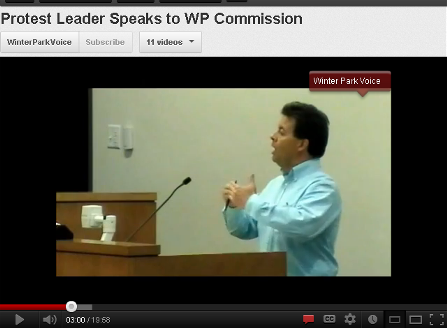 Video of the Sept. 10 Commission meeting shot by the Voice shows Rogers and others speaking out at the meeting urging Commissioners to scuttle the proposed permanent ordinance that restricts residential protest activity. Video of the Sept. 10 Commission meeting shot by the Voice shows Rogers and others speaking out at the meeting urging Commissioners to scuttle the proposed permanent ordinance that restricts residential protest activity.
Despite the opposition of Rogers and his group, the Commission voted 4 to 1 vote in favor of the permanent ordinance — which now goes to a second and final hearing and vote on Sept. 24.
The only member of the Commission who voted against the new ordinance was Mayor Ken Bradley, who spoke out against the actions of the Aloma Avenue protesters, but could not justify voting for the ordinance on Constitutional grounds. WPV video (click image above) includes comments from Mayor Bradley and all Commissioners.
Group Lobbies Commissioners Inside and Outside Chambers: Warns of Coming Lawsuits
Outside the Commission chambers after the meeting, Rogers’ group questioned Commissioners and City Attorney Larry Brown, challenging the actions of the Commission and explaining their opposition to the new ordinance.
In an encounter between the group and Commissioner Cooper, the Voice witnessed protest supporters standing around Ms. Cooper in the darkness outside City Hall attempting to win her over. As the Commissioner stood her ground, the group expanded its arguments to include the claim that the city could be bankrupted by lawsuits challenging the city’s new ordinance. Ms. Cooper was unswayed. A few minutes later, the group disbanded peacefully and the Commissioner continued on her own, down the steps, into the night.
On Monday September 24, starting at 3:30 pm, the Commission will conduct a final hearing of the ordinance and cast a final, deciding vote.
|
Recent Comments